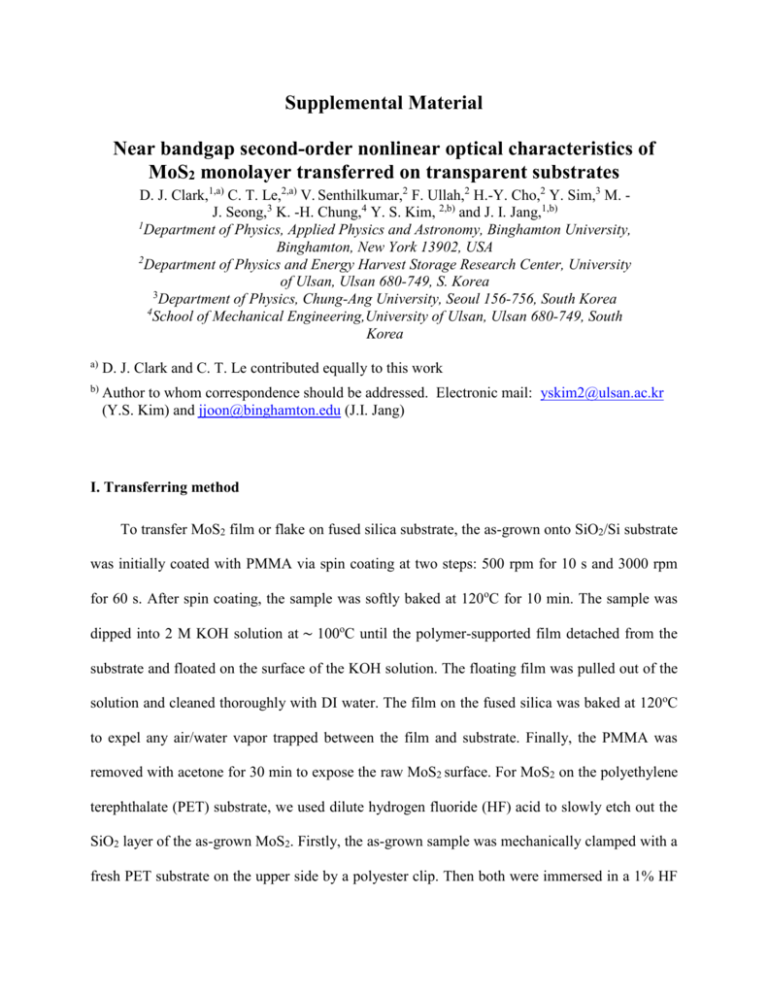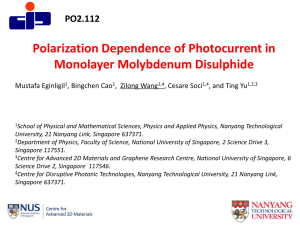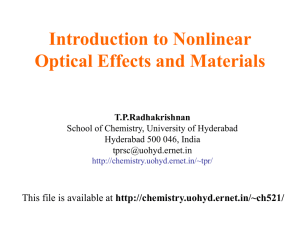Revised Transparent MoS2 SM
advertisement

Supplemental Material Near bandgap second-order nonlinear optical characteristics of MoS2 monolayer transferred on transparent substrates D. J. Clark,1,a) C. T. Le,2,a) V. Senthilkumar,2 F. Ullah,2 H.-Y. Cho,2 Y. Sim,3 M. J. Seong,3 K. -H. Chung,4 Y. S. Kim, 2,b) and J. I. Jang,1,b) 1 Department of Physics, Applied Physics and Astronomy, Binghamton University, Binghamton, New York 13902, USA 2 Department of Physics and Energy Harvest Storage Research Center, University of Ulsan, Ulsan 680-749, S. Korea 3 Department of Physics, Chung-Ang University, Seoul 156-756, South Korea 4 School of Mechanical Engineering,University of Ulsan, Ulsan 680-749, South Korea a) D. J. Clark and C. T. Le contributed equally to this work b) Author to whom correspondence should be addressed. Electronic mail: yskim2@ulsan.ac.kr (Y.S. Kim) and jjoon@binghamton.edu (J.I. Jang) I. Transferring method To transfer MoS2 film or flake on fused silica substrate, the as-grown onto SiO2/Si substrate was initially coated with PMMA via spin coating at two steps: 500 rpm for 10 s and 3000 rpm for 60 s. After spin coating, the sample was softly baked at 120oC for 10 min. The sample was dipped into 2 M KOH solution at ∼ 100oC until the polymer-supported film detached from the substrate and floated on the surface of the KOH solution. The floating film was pulled out of the solution and cleaned thoroughly with DI water. The film on the fused silica was baked at 120oC to expel any air/water vapor trapped between the film and substrate. Finally, the PMMA was removed with acetone for 30 min to expose the raw MoS2 surface. For MoS2 on the polyethylene terephthalate (PET) substrate, we used dilute hydrogen fluoride (HF) acid to slowly etch out the SiO2 layer of the as-grown MoS2. Firstly, the as-grown sample was mechanically clamped with a fresh PET substrate on the upper side by a polyester clip. Then both were immersed in a 1% HF solution for 5 min. The SiO2 layer was instantly attacked by the HF acid leaving the MoS2 monolayer on the PET substrate. The transferred MoS2 was taken out of solution and rinsed with DI water, then baked at 100oC for 10 min to enhance adhesion between MoS2 and the new substrate. II. Photoluminescence of MoS2 on PET substrate Since the PET substrate exhibited a comparable PL response, we performed a spectral subtraction to obtain the PL spectrum of solely MoS2. First, we excited the MoS2 sheet and the PL was collected where the signal is a result of the MoS2 and PET simultaneously. Then we excited a section of bare substrate to isolate the PL signal of the PET. The resulting spectral subtraction was the PL response of the MoS2 sheet (green plot) as shown in Fig. S1. Fig. S1. PL responses measured by MoS2 on PET (black), bare PET substrate (red), and the spectral subtraction yielding MoS2 PL (green). III. NLO experimental setup For all NLO experiments, the excitation source was an EKSPLA Nd:YAG laser with a 30 ps temporal pulse width and 50 Hz repetition rate which synchronously pumped an EKSPLA PG 403 optical parametric oscillator (OPO). The spectral width of the laser pulse from our OPO is less than 12 cm-1. A schematic of the SHG microscopy setup is shown in Fig. S2. The MoS2 sample was mounted onto a homemade sample holder which included three translation stages providing degrees of freedom in the x, y, and z directions. During the SHG measurements, a tungsten filament lamp illuminated the sample (yellow rays) and was imaged with a CMOS camera (Thorlabs). A 10 × objective lens focused the IR beam (red ray) to a spot size of ∼ 30 µm in diameter at normal incidence. The corresponding irradiance is ∼ 2.4 GW/cm2, which is well below the optical damage threshold. A beam splitter reflected the SHG beam (blue rays) which was then focused onto a fiber optic bundle and spectrally resolved via a selective-grating Horiba iHR320 spectrometer equipped with a CCD camera. The transmitted SHG beam was also collected and focused onto a moveable fiber bundle. We confirmed that there is no measurable contribution from electric quadrupole SHG arising from any symmetry-breaking interface. To check the crystallinity of CVD-grown MoS2 monolayer, SHG polarization dependence was measured on the as-grown MoS2 with reflection geometry. An excitation wavelength of 𝜆 = 1280 nm was chosen since it spectrally lies between the A- and B-exciton states. The polarization state of the excitation beam was fixed to vertical polarization with a half-wave plate (𝜆/2) and the detection analyzer was set to be either parallel or orthogonal to the input polarization. A single MoS2 monolayer flake was then rotated through one full turn and the SHG signal was monitored in 10° increments. Fig. S2. Optical setup for NLO measurements on MoS2 monolayer. The half-wave plate and detection analyzer were removed for the broadband SHG measurement. To examine the 𝜒 (2) dispersion of the monolayer, spectrally narrow coherent radiation was generated within the range of 𝜆 = 1064 – 1600 nm. The fundamental laser wavelength was tuned in steps of 25 nm. This corresponds to an SHG spectral range of 𝜆𝑆𝐻𝐺 = 532 – 800 nm which encompasses the spectral peak positions of both A- and B-exciton states and allows us to probe any excitonic resonance effects. The polarization state of the IR beam remained unchanged during the broadband measurement and the half-wave plate was removed from the optical setup along with the analyzer. For the MoS2 monolayer on transparent substrates, the reflected and transmitted SHG signals were simultaneously measured (as shown in Fig. S2). All SHG signals measured across this spectral range were properly scaled in accordance with known efficiencies of optical components and detectors. We confirmed that there is no measurable PL when 𝜆 is two-photon resonant with the exciton levels. IV. Polarization-dependent SHG The crystal structure of the as-grown monolayer (SiO2/Si substrate) was probed via SHG polarization dependence where the parallel and perpendicular component of the SHG with respect to the fundamental polarization is expected to be proportional to cos 2 [3(𝜃 + 𝜃0 )] and sin2 [3(𝜃 + 𝜃0 )] respectively. Here, 𝜃 is the angle between the fundamental beam polarization and the mirror axis of the crystal, and 𝜃0 is the initial offset angle.1-3 The expected six-fold polarization dependence for normal incidence was confirmed as shown in Fig. S3. Fig. S3. SHG polarization dependence for parallel (blue dots) and perpendicular (red dots) components along with theoretical fits to the data (solid traces). V. 𝑻/𝑹 calibration with bulk quartz Before broadband SHG measurements were carried out on MoS2 samples, the SHG ratio 𝑇/𝑅 was initially measured for the bulk quartz crystal where the ratio is predicted to be 25 assuming a refractive index n = 1.5. At normal incidence, the Fresnel coefficients are 𝑇 = 4 2 4 2 2 1 2 1 2 2 (𝑡𝑎𝑞 ) (𝑡𝑞𝑎 ) and 𝑅 = (𝑡𝑎𝑞 ) (𝑟𝑞𝑎 ) (𝑡𝑞𝑎 ) where superscripts represent the Fresnel coefficient for the fundamental (1) or SHG (2) beam and subscripts represent the boundary media. For 1 example, (𝑡𝑎𝑞 ) represents the transmission coefficient of the fundamental beam from air to quartz. The measured SHG signals in transmission and reflection mode for quartz are shown in Fig. S4. The 𝑇/𝑅 ratio is close to the predicted value and the broadband SHG response shows a series of oscillations. These oscillations are a result of spectral Maker fringes caused by a phasemismatch of the fundamental and SHG beam as they propagate through the quartz crystal. The red plot overlaid on transmission data is a theoretical fit to the SHG intensity using a bulk SHG model.4 Fig. S4. Broadband SHG responses of a single-crystal quartz in transmission (dots) and reflection (circles) modes. The red plot overlaid on the transmission data is a bulk SHG fit that takes into account the spectral Maker fringe effect. IV. Calculation of 𝝌(𝟐) The SHG intensity 𝐼𝑀𝑜𝑆2 (2𝜔) at frequency 𝜔 from the MoS2 monolayer on a substrate is (2) related to the sheet second-order nonlinear tensor 𝜒𝑀𝑜𝑆𝑠ℎ𝑒𝑒𝑡 by5,6 2 2 (2) 𝐼𝑀𝑜𝑆2 (2𝜔) = 512𝜋 2 𝜔2 |𝜒𝑀𝑜𝑆𝑠ℎ𝑒𝑒𝑡 | 𝐼 2 (𝜔) 2 6 [𝑛𝑞 (𝜔) + 1] 𝜖0 𝑐 3 . (1) The SHG intensity 𝐼𝑞 (2𝜔) from bulk quartz can be written as4 (2) 2 𝐼𝑞 (2𝜔) = 𝜔2 |𝜒𝑞 | 𝐿2𝑞 𝐼 2 (𝜔) 2𝑛𝑞2 (𝜔)𝑛𝑞 (2𝜔)𝜖0 𝑐 3 sinc 2 ( Δ𝑘𝑞 𝐿𝑞 ). 2 (2) Near the SHG wavelength of a constructive Maker fringe, sin2(Δ𝑘𝑞 𝐿𝑞 /2) = 1 and this eliminates the 𝐿𝑞 dependence for the reference at the maximum SHG in our calculation. By balancing Eqs. (1) and (2) for the same input intensity 𝐼(𝜔) , and including the Fresnel (2) coefficient of quartz, 𝐹𝑞 , we can express the bulk-second order susceptibility 𝜒𝑀𝑜𝑆2 as (2) (2) 𝜒𝑀𝑜𝑆2 = 𝜒𝑀𝑜𝑆𝑠ℎ𝑒𝑒𝑡 2 Δℎ = 𝜒(𝑞2) [𝑛𝑞 (𝜔) + 1] 3 1/2 𝜆 𝐼𝑀𝑜𝑆2 (2𝜔) 𝐹 . ) ( ) 𝜆𝑞 𝐼𝑞 (2𝜔) 𝑞 ( ) 16𝜋ΔℎΔ𝑘𝑞 𝑛𝑞 (𝜔)𝑛1/2 2𝜔 𝑞 ( (3) REFERENCES 1 Y. Li, Y. Rao, K. F. Mak, Y. You, S. Wang, C. R. Dean, and T. F. Heinz, Nano Lett. 13, 3329 (2013). 2 N. Kumar, S. Najmaei, Q. Cui, F. Ceballos, P. M. Ajayan, J. Lou, and H. Zhao, Phys. Rev. B 87, 161403 (2013). 3 L. M. Malard, T. V. Alencar, A. P. M. Barboza, K. F. Mak, and A. M. de Paula, Phys. Rev. B 87, 201401 (2013). 4 R. Boyd, Nonlinear Optics, Nonlinear Optics Series, Elsevier Science, (2008). 5 L. M. Malard, T. V. Alencar, A. P. M. Barboza, K. F. Mak, and A. M. de Paula, Phys. Rev. B 87, 201401 (2013). 6 N. Bloembergen and P. S. Pershan, Phys. Rev. 128, 606 (1962).







